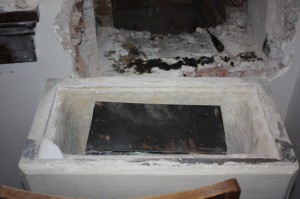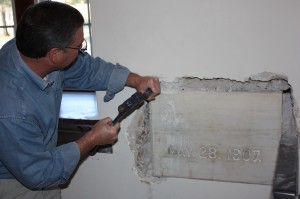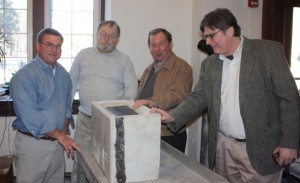
TUSCALOOSA, Ala. — Mystery surrounds a small charcoal-gray box recently removed from the cornerstone of Smith Hall, home of the Alabama Museum of Natural History on The University of Alabama campus. Nobody knows what’s inside the shoe-box sized copper container encased on May 28, 1907.
But, on Saturday, April 10, the world will find out, thanks to the efforts of Randy Mecredy, director of the museum. He’s just as curious as anybody about the box’s contents, which will be opened live during a celebration of Smith Hall’s 100th anniversary.
“We’ve searched the papers of Hill Ferguson, president of the alumni, who was present when the cornerstone was laid,” Mecredy says. “It just mentions that it contained ‘documents and souvenirs which would help some yet unborn generation glimpse the glory of the day.’”
Mecredy and University Museums staff members removed the box recently from the sealed concrete cornerstone. He chiseled away the seal, pried open the cover and revealed the well-preserved box. The box now sits in Smith Hall, keeping its secrets just a little while longer.

On Saturday, April 10, the Museum will host a Homecoming event from 10 a.m. to noon that is free and open to the public. The box will be opened live on a table in the Grand Gallery during that time.
A camera will be on hand to record the opening, and visitors can watch on a large-screen television. The event also will include activities for children, such as a build-your-own time capsule they can take home, and refreshments.
The Homecoming will also feature the opening of an exhibit displaying photos from the construction of Smith hall, which was dedicated May 5, 1910.
The building’s Beaux-Arts architecture, with its striking Grand Gallery on the second floor, surrounded by Corinthian columns, was meant to reflect, on a smaller scale, the grandiose national history museums built in Chicago, New York and Washington, D.C.
Smith Hall, which houses the Alabama Museum of Natural History and classrooms for the department of geological sciences, is the oldest building in Alabama built specifically as a museum, Mecredy says. The building is named for Dr. Eugene Allen Smith, a UA professor who also served as state geologist and spent nearly 50 years surveying, mapping and collecting scientific specimens throughout the state of Alabama.

“Most of our collections, especially those that have economic and geological value, can be attributed to Smith,” Mecredy says. “He spent his summers mapping the geology of Alabama and collecting specimens and samples.”
The building has extensive displays of geology, zoology, mineralogy, paleontology, ethnology, history and photography.
Also on display are the Hodges meteorite, the only meteorite confirmed to have struck a human, and the State Fossil of Alabama: Basilosaurus cetoides. These collections make the museum the key place where Alabamians can learn about their natural heritage.
“We are the repository for natural history for Alabama,” Mecredy says. “I think one of our most important collections are the photographic collections that we have. They document so much of our landscape before it was developed.”
The upper floor houses a lecture hall along with several geological teaching laboratories and offices. The museum is situated on the ground floor as well as the upper floor’s center area. Operating hours and other information can be found on the Alabama Museum of Natural History Web site. UA students and faculty have free admission.
Contact
Randy Mecredy, 205/348-2136, rmecredy@bama.ua.edu; Richard LeComte, UA Media Relations, rllecomte@ur.ua.edu, 205/348-3782